
Q. Belaying – From the 'rope loop' or from the harness 'belay loop'. Which is right?
A. Both.
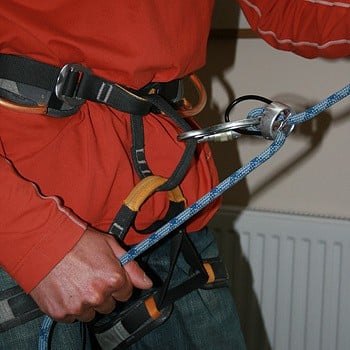
Harnesses come with a 'belay loop'. In most current models this belay loop connects the waist belt to the leg loops and is an extremely strong part of the harness. Some people call these loops 'abseil loops'. Both terms are correct. (There are other designs of harnesses that have a slightly different 'belay loop' - but for the purpose of this article all belay loops do the same job). To keep things simple - we'll refer to the rope loop as 'Rope Loop' and the belay loop as 'Harness belay loop'.
This 'Harness Belay Loop' is designed to be more than strong enough to belay from and to abseil on. In the harness pictured; a DMM Maverick , the strength of the Belay Loop is 25kn (that is strong - a no. 9 wire is rated to 12kn).
In certain circumstances it is usual to belay from this 'harness belay loop'. These circumstances are usually when there is no need for the belayer to be attached to anchors. A common instance of this is at the climbing wall or when sport climbing. It would be extremely inconvenient for a belayer to have to tie in to the bottom end of the rope before every route at an indoor climbing wall.
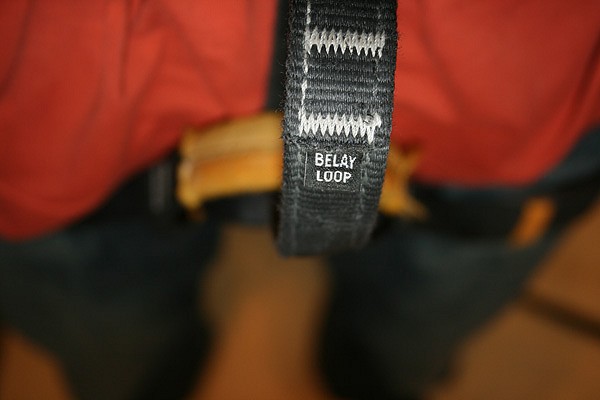
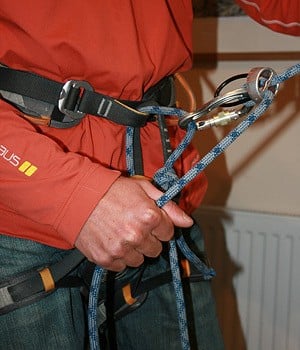
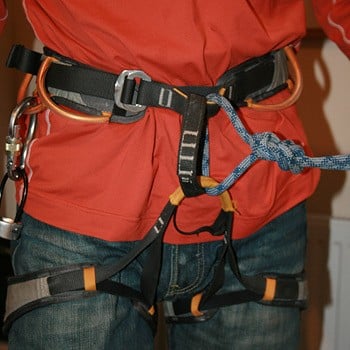
When a climber ties in to a rope, this is usually done by threading the rope through both the waist belt and the leg loops of the harness (as shown in this photo). The rope follows the same path through the harness as the 'harness belay loop' – in effect, creating a new 'belay loop' from the rope.
This 'rope loop' is extremely strong and is perfectly adequate for belaying from. In fact, it is a very good idea to use this 'rope loop' in certain circumstances.
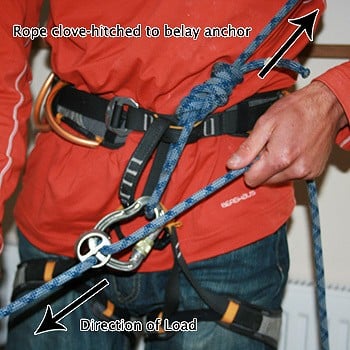

If you are attached to an anchor point with your rope, be it on a ledge or at the top of a crag, then it can be a good idea to belay from your rope loop. In doing so you are more able to transfer the weight of a fallen climber more directly on to your belay and avoid the squashing sensation caused through having your harness pulled.
The obvious exception to this rule is if you have attached yourself to your anchor point using your harness belay loop - usually with a sling and karabiner.
In some instances having the entire weight of a fallen climber pressing on your 'particulars' can be extremely uncomfortable:
The side load shown in the photo on the right causes the harness to twist and can cause discomfort for the belayer. But is it more likely to make the harness fail? I didn't know the answer to this so I asked the experts:
Simon Marsh from DMM explains:
"Side loading the belay loop will not cause a significant increase in loading or affect the ability of the loop to hold that load. The main issue with side loading is that a sudden, twisting of the harness may cause the belayer to lose control of the rope. Otherwise discomfort is the most common side effect of twisting caused by the side load; the load may not be in line with the belay and the harness will try to twist into line and thus press into the belayers waist."
Common Statements - Explained and exploded:
"Belaying from the rope loop adds more elasticity to the system."
Whilst there is an element of truth to this, a metre of rope loop will not add a huge amount of stretch to any system. Some 'give' is introduced by the knot in the rope loop tightening up, but not a huge amount. Far more dynamism can be given through the length of rope out to the climber, or through giving a slightly dynamic belay or rope slippage through the belay plate.
"Belaying from the harness loop puts less load on 'dodgy' belay anchors as the body takes some of the impact."
This can be correct as belaying from the harness loop can be used to slightly reduce impact on to a belay by taking some of the force through the legs of the belayer in a semi-braced stance. It all hinges on the position of the belayer, it is essential that you are well positioned and able to 'brace' against a fall.
George Mcewan from Glenmore Lodge shares his thoughts: Belaying from the rope loop can put more force on to the anchors. You can check this out by having the belay device clipped into the rope loop and have someone pull hard on the rope – you will feel more force bypassing the harness and straight onto the anchors. Repeat the same exercise but this time have the device clipped into the harness loop – all of the load goes onto the harness loop. How the belayer is set-up makes a huge difference in both cases but fundamentally belaying from the harness loop exerts less direct force on to the anchors."
Usually (with good solid anchors) putting more force on the anchors is a good move - it takes the strain off you and is easier to hold a fall. This should be about 99% of the time! If the anchors are bad, then ideally you should look for some better ones! If that really isn't possible (usually on some winter routes) then reducing impact on them is important - hence a braced position and clipping to the harness loop. It is also possible (but not as easy) to brace some of the impact when belaying from the rope loop - again it hinges on the position of the belayer. Another technique to give a dynamic belay is the 'body belay'. This is a tricky technique to get right, practice makes perfect.
"Belaying from the rope loop is a 'Direct Belay'"
False. A direct belay is where the belay plate is attached directly to the anchors and the belayer is not part of that system. This technique is often used in scrambling or by guides and instructors to safeguard clients on easier terrain. It is also a handy technique if a climber has forgotten their belay plate - an Italian Hitch can be used to good effect on a direct belay.
"You can't escape the system if you belay from the harness 'belay loop'"
False. You can escape the system from either belay set-up, or even if you have clipped through both the rope loop and the harness belay loop. The difference can be that if you have the weight of a fallen climber hanging directly from your harness loop, this can make escape awkward due to the difficulty of moving around with this weight on you. All in all this isn't really a huge deciding factor in how to arrange your belay.
Escaping the system is a technique that requires some equipment and knowledge and is best practised before a real accident (and best practised close to the floor!).
To Summarise:
Rope loop or belay loop? - Both are correct in different circumstances, but it won't really matter if you prefer one over the other.
- If you are tied to the anchors – rope loop is usually best.
- If you are not tied to the anchors – belay loop is usually fine.
- If in doubt - why not just clip through both?
Important Tips:
Tie your rope loop the same size as your harness belay loop. Don't have it too long or really short. This makes belaying from it easier, and keeps everything neat when you are climbing.
Make sure your knot is well tied, tight and has a stopper knot. Adding a stopper knot adds another link to the safety chain.
Don't rely on basic rules such as 'when I'm on the floor I do X' or 'when I'm on a ledge I do Y'. Keep asking questions and experimenting in a safe place until you understand not just what to do, but WHY you should do it.
If you're worried about poor belay anchors, the usual best thing to do is find some better ones, not worry about braced stances and body belays! It can be difficult to find bomb-proof belays on some winter routes, but the majority of rock climbs in the UK have good belays, if you work hard to find them.
Further Reading:
- Trad CLIMBING+ (right) by Adrian Berry and John Arran
- Rock Climbing: Essential Skills & Techniques by Libby Peter
- The Complete Guide to Rope Techniques by Nigel Shepherd
- Rock Climbing by Pete Hill
Get instruction in rope techniques from a member of the Association of Mountaineering Instructors
Thanks to Simon Marsh from DMM and to Steve Mayers of the Beacon Climbing Centre and to George Mcewan of Glenmore Lodge and to everyone who contributed valuable information both directly to me and through the forum thread.







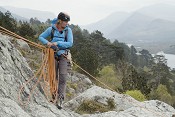


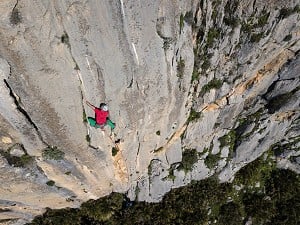
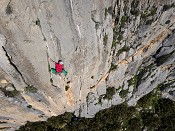








Comments